Let me share a feasible plan. If you can carry it out, it's possible to earn 1 million from 3,000.
I went from entering the cryptocurrency market with 100,000 to making a profit of 10 million, then going into debt of 8 million, then to a profit of 42 million, and now to financial freedom. In the last two years, from 2024 to 2025, I achieved a return rate of 418134.86% with less than 200,000. I managed to reach over 42 million. Here are some practical and useful suggestions for those just entering the cryptocurrency market!
Why I entered the market:
Many opportunities: The cryptocurrency market trades 24 hours a day, without the need to clock in for work. Seizing a bull market can be equivalent to ten years of salary (for example, a Trump concept coin might rise by 15,000% in a single day in 2025).
Skill upgrades quickly: Keeping a close watch on the market daily can develop market instincts; understanding technical analysis and on-chain data allows you to transition to being an analyst or media personality if you do well.
The temptation to get rich quickly: Those who hoarded Bitcoin early saw the price exceed 80,000 dollars by 2025, and many had their assets multiply by dozens of times, leading to envy.
My method for trading cryptocurrencies is very simple and practical:
Many people think that trading cryptocurrencies relies on 'insider information' or 'accurate predictions'. In fact, ordinary people can make money just by adhering to simple discipline.
I summarize the 'Five-Step Batch Method', suitable for all players with limited capital:
1. Divide the funds into 5 parts of 2,000 each; only use one part each time, and never touch the remaining funds—this is to avoid the impulse of putting it all in at once.
2. Use 2,000 to test the waters
Choose a coin you are optimistic about and first buy 2,000 worth of spot. Remember, newcomers should never touch leverage; the volatility of spot trading is already enough to double small capital.
3. After a 10% drop, add to the position. If it drops 10% after purchase, add another 2,000. At this point, your cost has decreased by 5%, so only a 5% rebound is needed to break even, which will significantly reduce psychological pressure.
4. Take profit at 10% and sell half, regardless of how much it may rise afterward, sell half to lock in profits. For example, if you invest 2,000 and it rises to 2,200, sell 1,000; even if the remaining 1,000 drops back, you still made a profit of at least 100.
5. Cycle operations to let profits roll in. Use the money from taking profits to find new coins and repeat the previous steps. Using this method with 10,000, it's not difficult to multiply it by 5-10 times in a year, the key is not to be greedy, and be satisfied with making 10% each time.
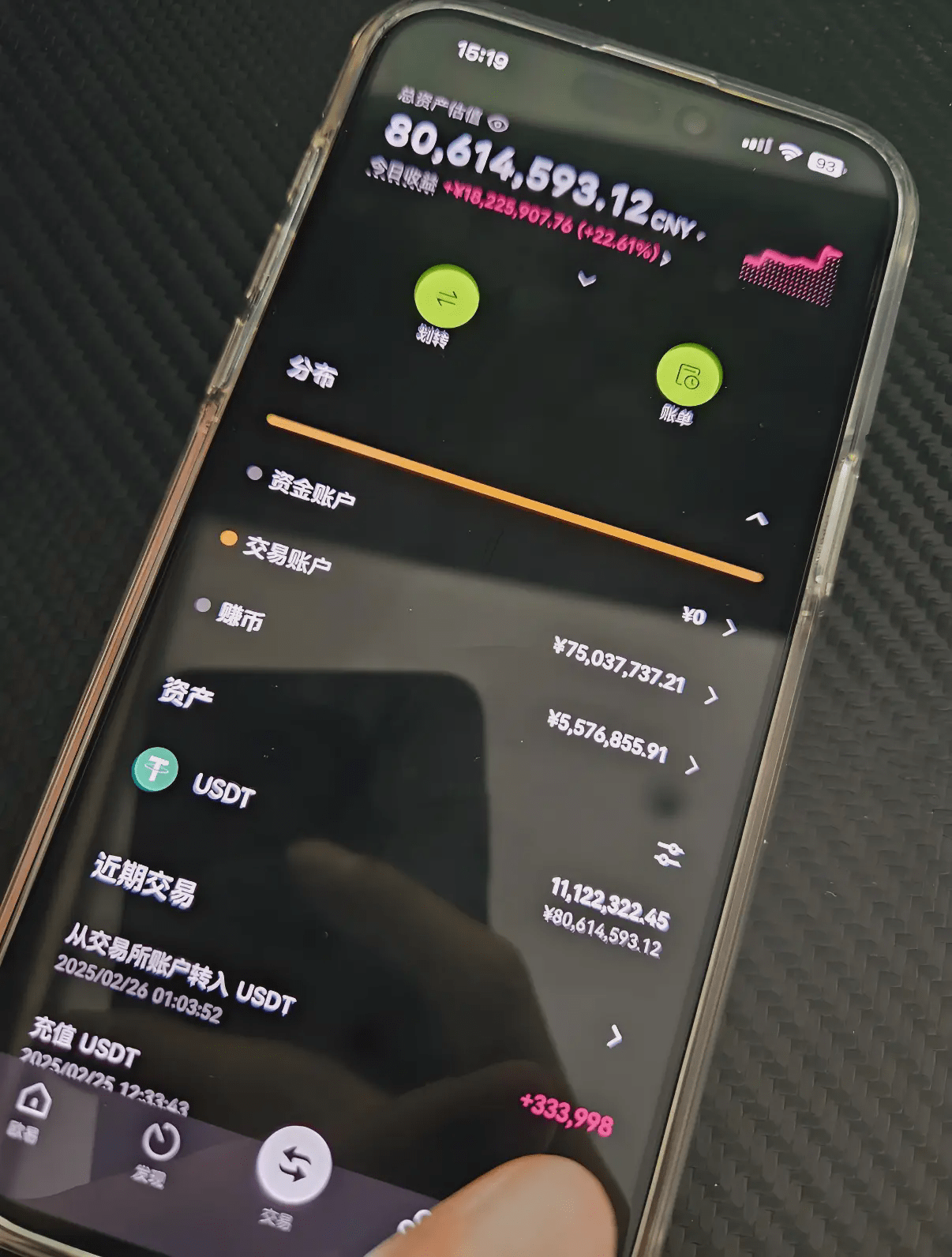
In the cryptocurrency sphere, achieving financial freedom and class transition, summarized 10 trading tips. Understand one, and you can stabilize profits; it is worth learning repeatedly.
1. Two-way trading: Suitable for bull and bear markets. Two-way trading is currently the most common trading method at Giant Wealth GGtrade, allowing for operations based on the trends in the coin market; it can buy up and also buy down. With the approach of the end of the year, Giant Wealth GGtrade has also launched a series of promotional benefits, such as a 20% increase in investment returns, which is a great boon for investors.
2. Hoarding method: Suitable for bull and bear markets. The hoarding method is the simplest yet the hardest strategy. The simplest part is just buying a coin or several coins and holding for six months or more without operating. Generally, the minimum return will be tenfold. But newcomers often see high returns or encounter price halving and plan to switch coins or exit, and many find it challenging to stick to not operating for a month, let alone a year. So, this is actually the hardest part.
3. Bull market chasing dips: Only suitable for bull markets. Use a portion of idle funds, preferably not exceeding one-fifth of your total funds. This strategy is suitable for coins with a market cap between 20-100, as they won't be stuck for too long. For example, if you buy the first altcoin and it rises by 50% or more, you can switch to the next coin that has fallen sharply, and continue this cycle. If your first altcoin gets stuck, just wait; the bull market will definitely allow you to break even. The premise is that the coins shouldn't be too disappointing; this strategy is actually hard to control, and newcomers should be cautious.
4. Hourglass method: Suitable for bull markets. In a bull market, buying any coin generally rises. Funds are like a giant hourglass that slowly seeps into each coin, starting from major coins. There is a clear pattern in coin prices; the leading coins rise first, such as BTC, ETH, DASH, and ETC, followed by mainstream coins like LTC, XMR, EOS, NEO, QTUM, etc. Then various small coins rise in succession. But if Bitcoin rises, choose the next level of coins that haven't risen yet and start building positions.
5. Pyramid bottom-picking method: Suitable for predicted major crashes. The bottom-picking method: Place orders to buy one-tenth of your position at 80% of the coin price, one-fifth of your position at 70% of the coin price, one-third of your position at 60% of the coin price, and one-fourth of your position at 50% of the coin price.
6. Moving average method: Understand some basics of candlestick patterns. Set the indicator parameters as MA5, MA10, MA20, MA30, MA60, and select a daily timeframe. If the current price is above MA5 and MA10, hold and remain steady. If MA5 falls below MA10, sell the coin; if MA5 rises above MA10, buy and establish positions.
7. Violent hoarding method: Focus on coins you are familiar with; suitable only for long-term quality coins. If a certain coin is currently priced at 8 dollars, place an order to buy at 7 dollars. When the purchase is executed, place an order to sell at 8.8 dollars. Use the profit to hoard coins. Withdraw the liquid funds and wait for the next opportunity. Adjust based on the current price. If there are three such opportunities in a month, you can hoard quite a bit. The formula is the buying price equals the current price multiplied by 90%, and the selling price equals the current price multiplied by 110%.
8. Aisle violent compounding method: Continuously participate in ICOs, and when the new coin rises by 3-5 times, take back the principal and invest in the next ICO, while continuing to keep the profits, cycling continuously.
9. Cycle swing method: Find coins like ETC that are continuously declining, add positions as the price drops, continue to add as it falls, and then sell when profits are made, continually cycle through.
10. Aggressive small coin strategy: If you have 10,000 RMB, divide it into ten parts, buying ten different types of small coins, preferably priced below 3 RMB. After buying, do not interfere. Do not sell until it has tripled to five times, and if you get stuck, do not sell, just hold it for the long term. If a coin triples, take out your 1,000 principal and invest in the next small coin. The compound returns can be astonishing!
Summary of the trading system: The essence of trading is: cut losses when wrong, hold when right, small losses and large gains, make big profits and losses. Specifically, for each core link:
1. Follow the trend: Find a simple moving average to delineate bullish and bearish positions; buy only above it and sell only below it.
2. Trial positions: Go with the trend, follow the big trend against the small trend, and consider the potential for a sufficiently large risk-reward ratio when entering. If you're wrong, the stop-loss is small, but if you're right, the profit is significant, generally at the trend bottom or early trend.
3. Trial position stop-loss: If a key point is broken, you must stop-loss without exceptions. If the price comes back, you can find another opportunity to re-enter. Do not have a mindset of hoping it will bounce back, and absolutely avoid averaging down losses.
4. Add trend positions: Add to profitable positions. Adding to positions is the core of making big money. After the price rises as expected, add to positions at the pullback support level or after breaking through previous highs—go with the big trend and against the small trend.
5. Set stop-loss for trend positions: For newly added trend positions, move the stop-loss to the new key point. The base position is already secure, leaving only the stop-loss risk for the added position. If it fails, stop-loss for the added position and wait for the next opportunity. If it continues to rise, hold firmly and wait for a pullback to add positions, continuing to move the stop-loss until the last move is stopped out or a top signal is triggered for profit-taking.
6. Take profit: Never take profits too easily; this is key to making big money. Exiting can be done in batches or all at once; it's best to do it all at once, as this forces yourself to wait for the highest probability top signal. If it's a right-side trade, will profits definitely retrace? You must accept this mentally. Don't think about selling at the highest point or feel regret if you didn't sell at the highest point and have to wait to sell at that point. As long as you can master and consistently follow these principles, maintaining discipline and consistency, you'll find that making money is a natural thing.
Copy trading must be 100%; otherwise, you won't make big money. Many people have misconceptions about trading. For example, they think small capital should focus on short-term trading to grow funds, which is completely wrong. This mindset is essentially trying to exchange time for space, aiming for overnight wealth. Small capital should focus on medium to long-term investments to grow.
Is one sheet of paper thin enough? If a sheet of paper is folded 27 times, it becomes 13 kilometers thick. If folded 10 more times, reaching 37 folds, it would be thicker than the Earth. If folded 105 times, the entire universe would not be able to contain it. If you have 30,000 principal, you should think about how to triple it in one wave and then triple it again in the next wave... this way, you will have four to five hundred thousand.
And not thinking about earning 10% today and 20% tomorrow will eventually lead to self-destruction.
Always remember, the smaller the capital, the more you should focus on long-term investing, relying on compound interest to grow large, rather than attempting short-term trading for small profits.
A guaranteed strategy to quickly earn the first 1 million and then the first 10 million (RSI technical indicator), with a win rate of up to 100%. Mastering it will benefit you for life! A must-read for technical traders! A divine trading indicator that lets you identify trends and breakouts in advance.
RSI Calculation Formula
RSI is typically calculated using the following formula:
RSI = 100 - [100 / (1 + RS)]
Among them, RS (Relative Strength) is the average of closing prices for x days when prices rise divided by the average of closing prices for x days when prices fall. The most common period is 14 days, but traders can adjust this value based on their preferences and trading style.
RSI Levels
0 to 30: Extremely oversold
Values below 30 indicate that the market is in a severe oversold state. Traders will pay attention to potential changes in price trends, that is, the existing downtrend may turn into a new uptrend.
However, this is not absolute. Always remember that a strong downward trend can cause the indicator to remain in the extremely oversold region for a long time. Therefore, blindly buying because the value is below 30 is not a good strategy.
Between 30 and 50: Slightly oversold to neutral
Values above but close to 30 indicate that the market is in a slightly oversold state. If the value is closer to 50, it is more likely to be in a neutral state.
Between 50 and 70: Neutral to slightly overbought
Values above but close to 50 are also considered neutral. However, if the value is close to 70, it indicates that the market is in a slightly overbought state.
70 to 100: Extremely overbought
This area is considered an extremely overbought region, where the market believes the upward trend may lose momentum and a genuine trend reversal may occur, turning into a downward trend.
Nevertheless, similar observations apply to oversold situations. A strong upward movement may attract more buyers into the market, causing the RSI to surge rapidly. This does not mean that the market cannot continue to rise strongly indefinitely.
Again, it's important to note that one should not automatically close long positions (or open short positions) just because the indicator is in an extremely overbought state.
“Please remember, these ranges are indicative only and should never be used as pure trading signals. The probability of false signals is very high if there are no additional elements to confirm overbought or oversold conditions.”
What settings to use?
The optimal parameter selection for this indicator entirely depends on personal preference, primarily based on the strategy you are using and the time frame it is executed in.
The default setting is 14 periods, with an upper limit of 80 and a lower limit of 30. Typical swing traders sometimes use a 20-period setting, as this roughly corresponds to a 1-month trading cycle on the daily chart.
Another option is to set the upper and lower limits to 80 and 20 respectively, slightly tightening the range. This will lead to fewer signals, but the signals will become more reliable and reduce the occurrence of false signals.
Overbought and oversold levels
The horizontal axis represents time, while the vertical axis ranges from 0 to 100 (which is why this indicator is called an oscillator).
◎ Above 50: The technical trend is positive.
◎ Below 50: The technical trend is negative.
It measures the speed and direction of price changes.
The general rule is:
◎ When the value is above 70, it is referred to as an 'overbought' signal, indicating that the price has risen significantly in a relatively short time, increasing the likelihood of a (temporary) decline.
◎ When the value is below 30, it is referred to as an 'oversold' signal, indicating that the price has significantly dropped, increasing the likelihood of a (temporary) rebound.
Visually, the indicator is shown as follows, where you can identify peaks above 70 and valleys below 30:

The RSI shown is based on the stock price chart of Cenovus Energy:
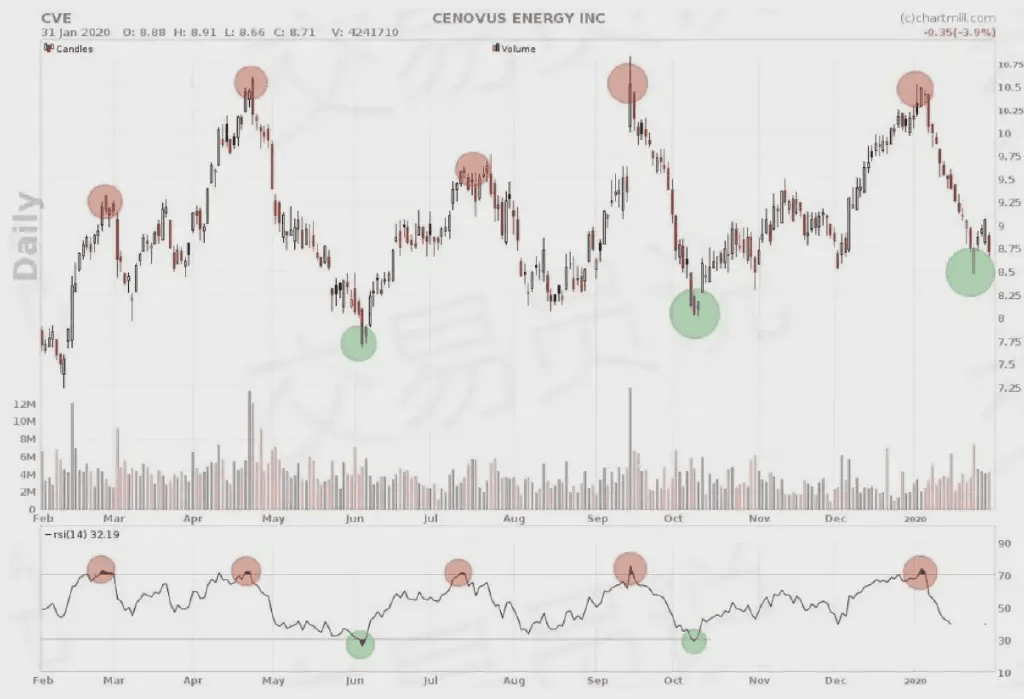
The red circles in the chart represent sell signals, while the green circles represent potential buy signals. Any trader who buys at the green circle and sells at the red circle has made a significant profit!
The chart shows that the RSI level provides good signals primarily in sideways markets.
Three different ways to use these levels in trading strategies.
We emphasize that the reliability of the RSI indicator highly depends on the market stage of the stock or market.
We distinguish the following phases:
◎ The price is in a sideways channel (consolidation area).
◎ The price shows a clear upward trend.
◎ The price shows a clear downward trend.
1. Sideways price channel
In a sideways price channel, we have seen classic buy and sell signals (buy at <30 and sell at >70) that are relatively reliable.
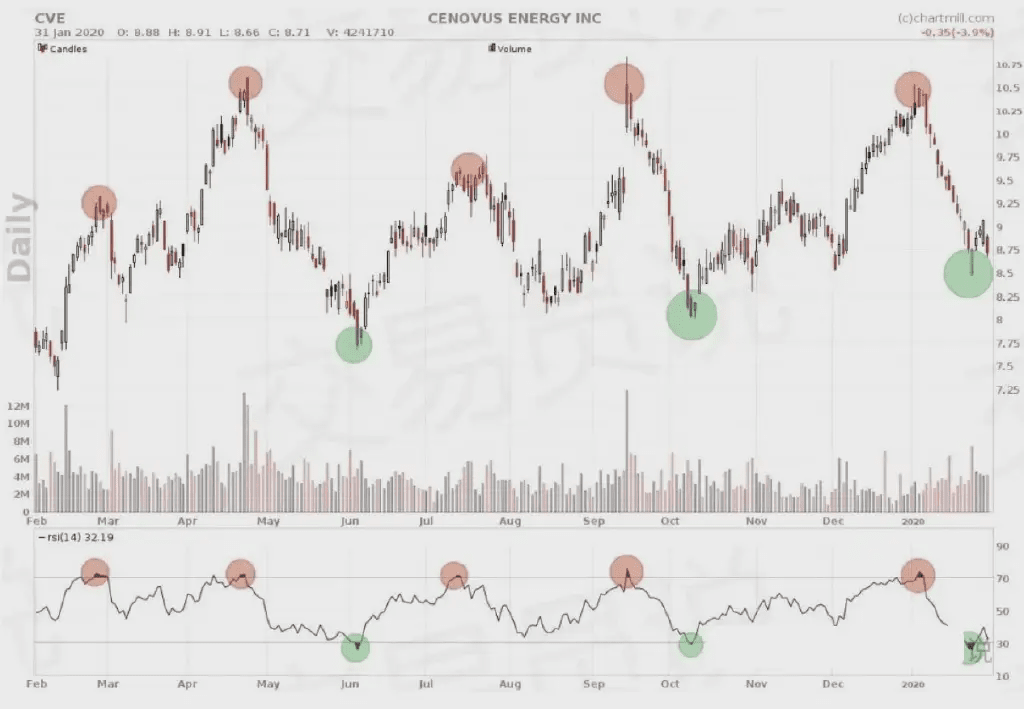
The stock price fluctuates within a wide sideways channel between approximately 10.75 dollars and 7.50 dollars. Each time it reaches one of the two boundaries, the price will either drop or rise. In this case, the RSI shows accurate signals.
2. Uptrend
In a price with a clear upward trend, classic usage methods are much less effective. The strong upward trend in the figure below is evident.
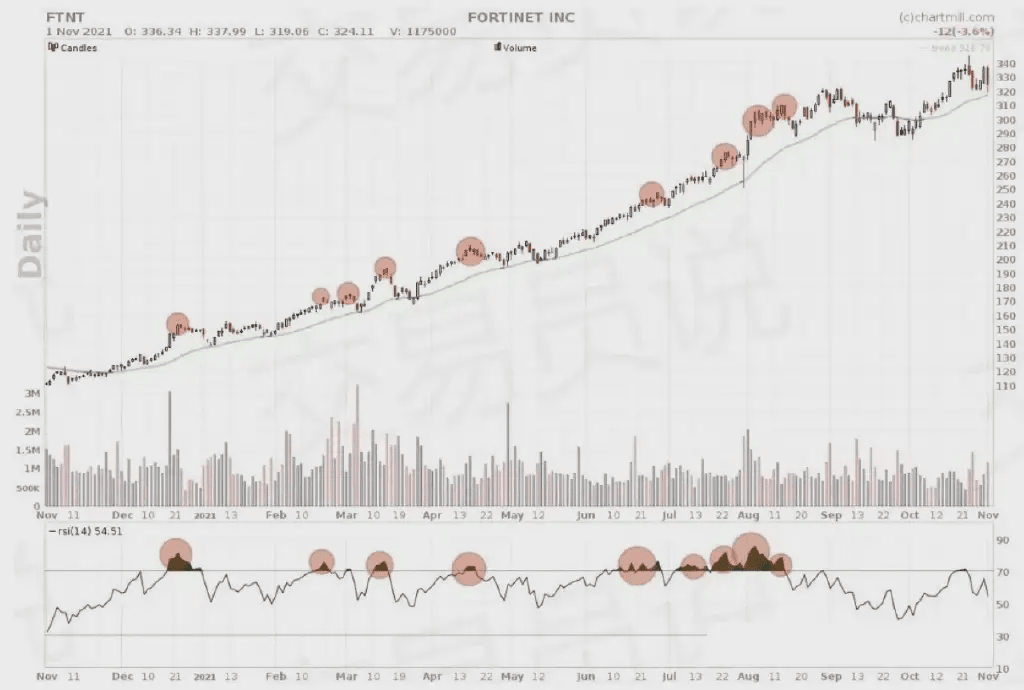
As long as the trend continues to rise, it is recommended to ignore sell signals. In this case, you can try to buy during a temporary drop in an upward trend.
Of course, you can also use the RSI indicator to achieve this. In the diagram below, we show the same chart but ignore sell signals and mark the moments when the RSI falls below the 50 level.
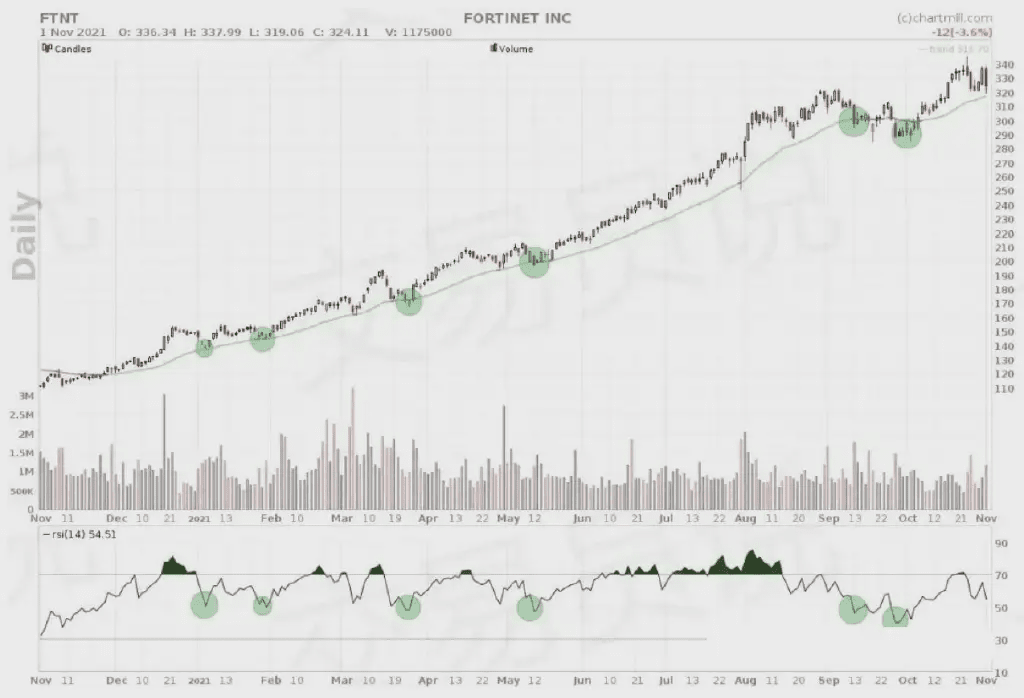
In an upward trend, buying when the RSI drops below 50 usually yields very good results and allows you to increase positions in the same stock (or other varieties).
3. Downtrend
Similar to an upward trend, if there is a sharp downward trend and prices temporarily rebound, RSI can also be used to short. In the diagram below, we marked the points where the trend indicator shows a downward trend (red line) as well as the occasional price rebound; at this point, the trend indicator turns neutral (gray) but never turns positive (green).
At these moments, when the RSI value exceeds 50, the indicator shows sell signals.
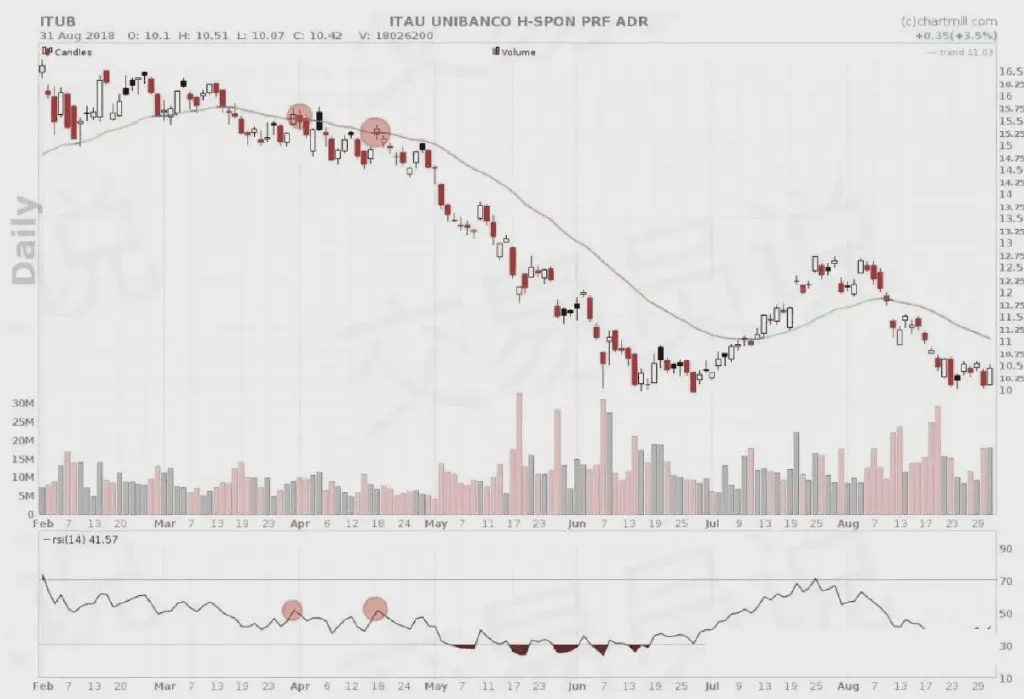
‘In stocks showing strong price trends (upward or downward), the classic lower and upper limits (30 and 70) are often too extreme in many cases. In these situations, the 50 level is better suited for identifying overbought or oversold periods.’
The power of divergence: Early detection of new price trends
Divergence means there is a discrepancy between the price evolution on the chart and the indicator trend.
Since this divergence often occurs just before the end of an existing long-term trend, active investors use it to identify early changes in long-term price trends, allowing them to establish new positions in the direction of the reversing trend.
Divergences are classified as bullish (positive) divergences and bearish (negative) divergences.
Bullish RSI divergence
Bullish divergence occurs when the price chart shows lower lows while the RSI chart shows the opposite trend. This is a signal that the intensity and momentum of the declining price trend are weakening (at least temporarily), increasing the likelihood of a temporary price rebound.
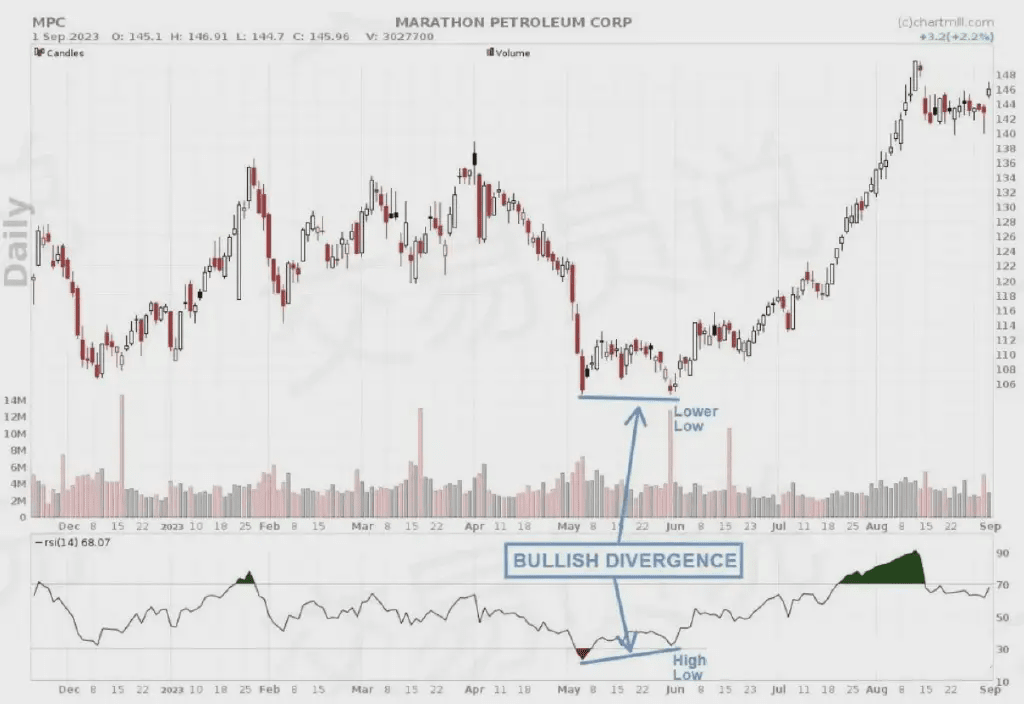
Bearish RSI divergence
When the indicator shows a lower peak while the price continues to rise, this is known as bearish divergence. It indicates that the strength and momentum of the upward price movement are weakening (at least temporarily), and there is a possibility of (mid-term) price decline.
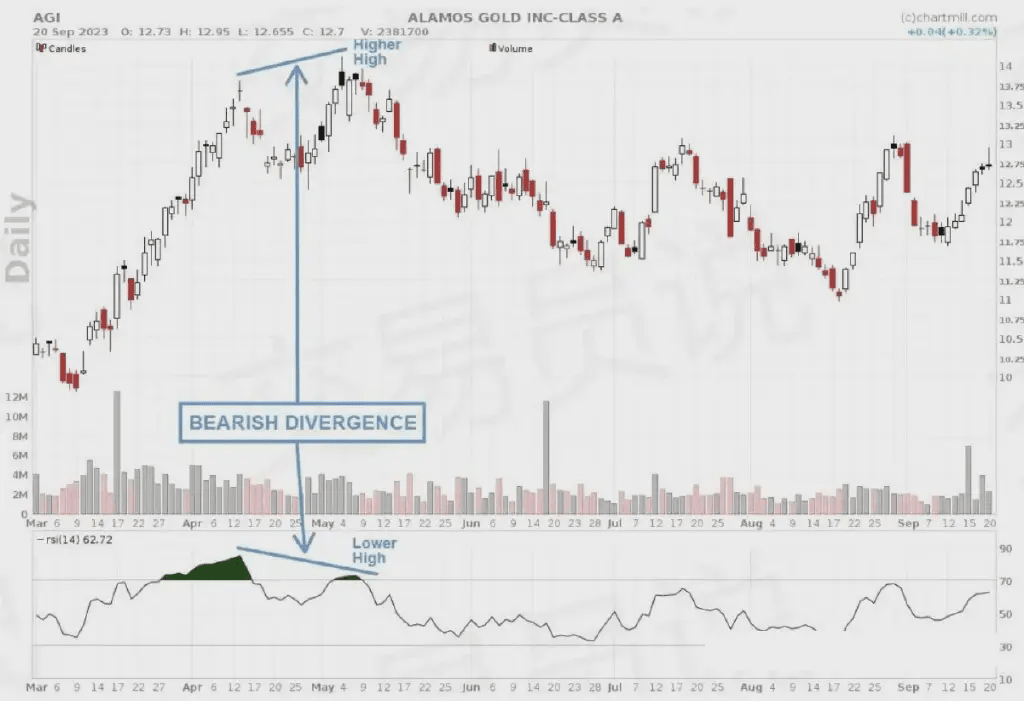
Hidden divergence: Utilizing temporary price changes within existing trends.
This form of divergence is a derivative of classic divergence, mainly occurring in stocks showing clear upward or downward trends.
Hidden divergences appear when the price temporarily drops in an upward trend or temporarily rebounds in a downward trend.
Example 1: Hidden divergence in an upward trend
The chart below shows Evercore stock, which has been in an upward trend since early June 2023. The recent price drop has resulted in a new higher low, but in terms of RSI, it has formed a lower low, creating a bullish hidden divergence.
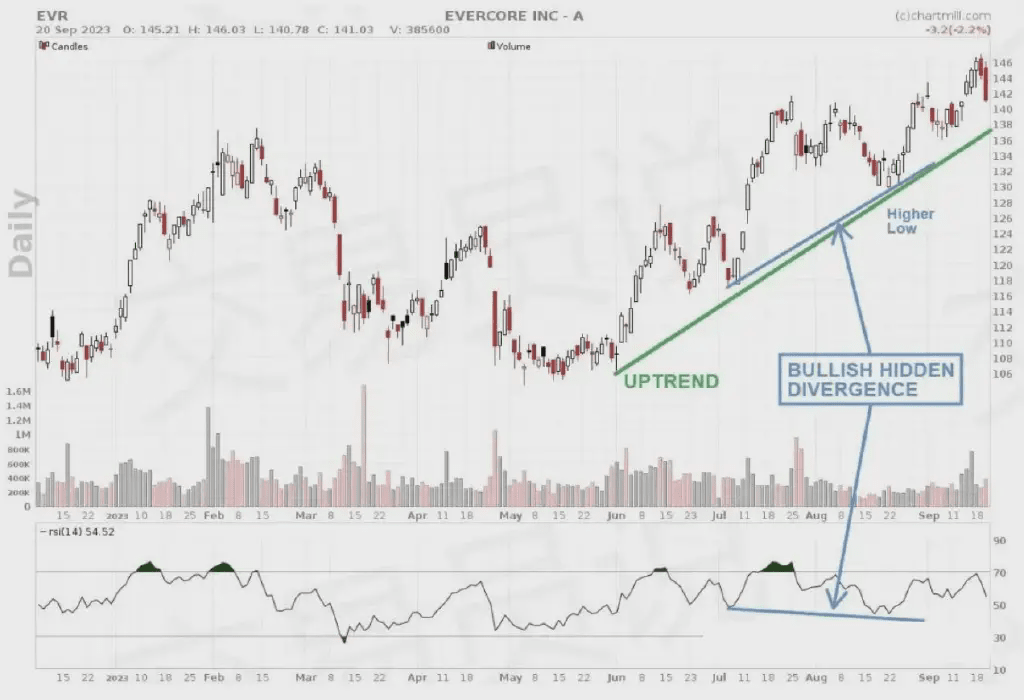
Example 2: Hidden divergence in a downtrend
Similar hidden divergences also occur in downtrends. Chemours stock reached a peak between July and August 2023, followed by a price drop that formed several consecutive lower lows. However, the recent lower highs in price have formed higher lows in the indicator, which is identified as a bearish hidden divergence.

How to use the RSI indicator for swing trading
As we mentioned at the beginning, the Relative Strength Index (RSI) is one of many technical indicators that technical analysts use to profit from short to medium-term price movements in the market.
After understanding the basic knowledge of RSI, we will detail the different steps for successfully using the RSI indicator in swing trading strategies.
1. Choose the appropriate time frame.
A typical swing trading strategy holds positions for days to weeks, so positions may also be held overnight.
The default setting for swing trading is a 14-period daily chart, which corresponds to a 14-day time frame.
Shorter time periods generate more signals, but the margin of error also increases. Using longer periods may result in missing part of the price movement.
2. Determine the current trend
Trading in the direction of the main trend has the highest probability of success. For instance, you can use the 200-day moving average to determine the long-term trend. For long positions, only choose stocks where the long-term moving average is trending upwards and the price is above it.
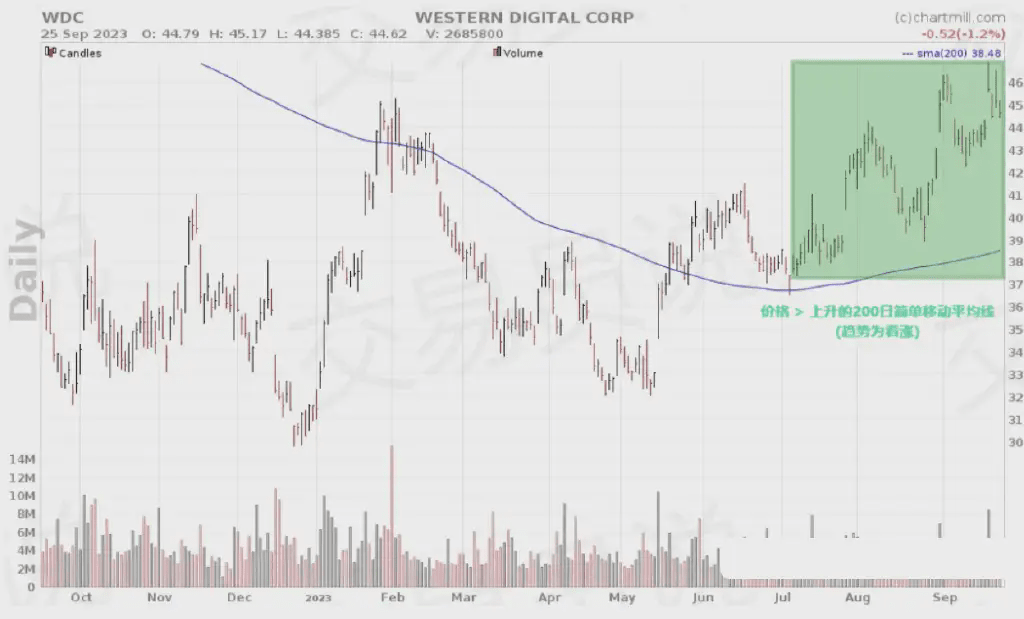
Another purely visual method to determine the current trend is to use an upward trend line (at least three connection points are needed).
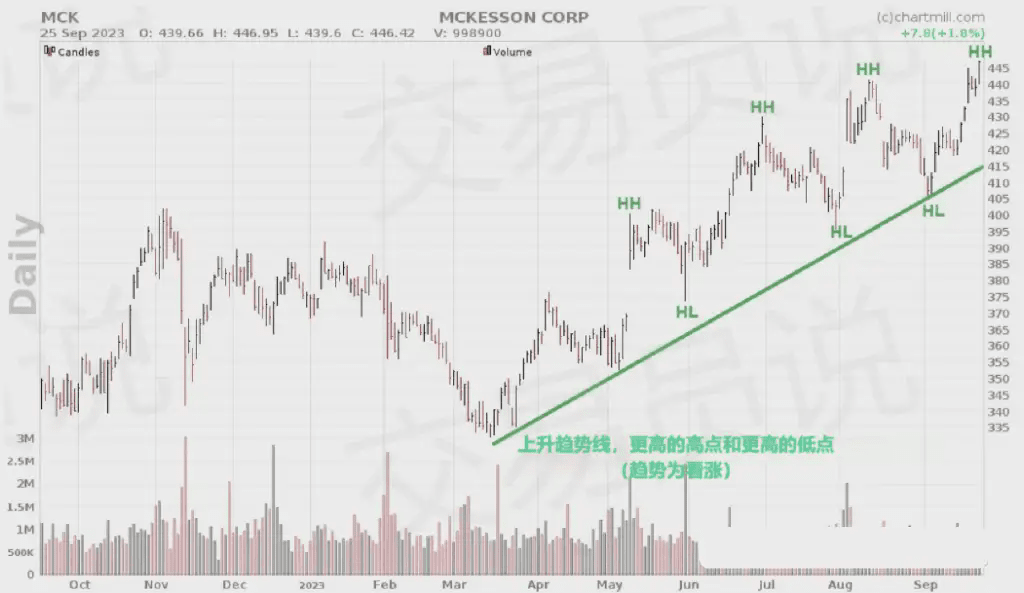
3. Determine (and optimize) RSI signals
As mentioned above, the RSI indicator's 70 and 30 values are typically used to identify overbought and oversold assets, which may signal potential trend changes.
However, do not get too caught up in these levels; many factors depend on the momentum and strength of the current trend. For instance, in a strong upward market, a temporary price reversal does not always lead to the RSI falling below 30.
Similarly, in a strong declining market, a temporary rebound in prices does not necessarily mean the RSI will rise above 70.
In the above situations, when the RSI rises from the 50 level, it may have triggered valid buy or sell signals.
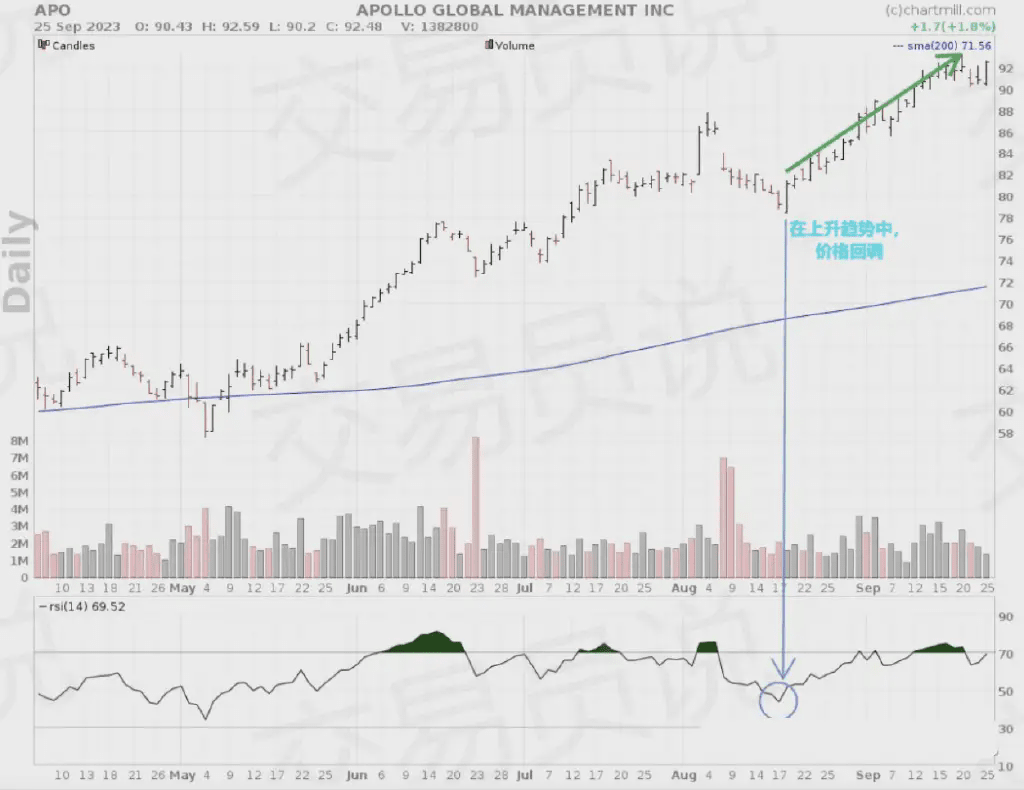
4. Do not rely solely on indicators
Technical analysis and its indicators cannot guarantee trading success. Trading purely based on this indicator or any other is the fastest way to incur losses!
As mentioned above, trade only in the direction of the long-term trend. After all, this will help you avoid many false signals.
Moreover, always pay attention to price action. Chart patterns, candlestick patterns, as well as support and resistance levels that appear simultaneously with indicator signals are important confirmation signals that can significantly enhance the reliability of the trading setup. Remember, the quantity of signals is not as important as their quality.
5. RSI divergence
In the previous text, we have understood the types of divergences and their meanings. When looking for entry points in a strong trend, hidden divergences are particularly important.
Hidden divergence is a derivative form of classic divergence, mainly occurring in stocks that show clear upward or downward trends.
Hidden divergences will manifest when the price temporarily retreats in an upward trend or temporarily rebounds in a downward trend.
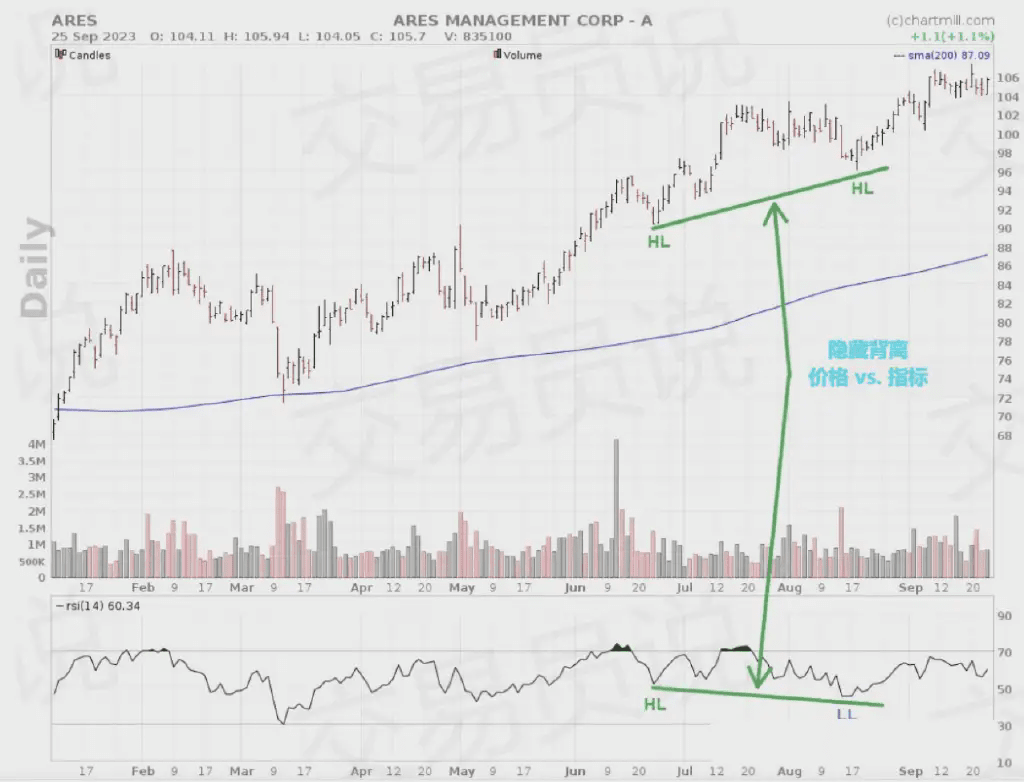
6. Accurately determine entry and stop-loss points
Develop a trading plan and execute trades according to the plan!
Based on your strategy, determine entry and stop-loss points in advance. This ensures that you can accurately determine and limit risk. After all, protecting account funds is every trader's top priority.
Exit points can be a predetermined fixed price level, but another option is to use a trailing stop-loss to profit from the trend for as long as possible and protect a larger portion of accumulated profits as the price continues to move favorably.
7. Position size and risk management
Equally important as the trading setup itself is how you determine position size and its associated risk (related to the set stop-loss).
Only those traders who can properly manage losing positions and ensure that losses remain within a small range can maintain long-term success. Five consecutive losses of 1% of the overall fund is not a disaster. However, several individual positions that lead to portfolio losses of several dozen percentage points are disastrous!
Frequently Asked Questions
1. What is the difference between RSI and Relative Strength?
‘RSI’ and ‘Relative Strength’ are sometimes confused because they both contain the phrase ‘Relative Strength’. However, they refer to completely different concepts:
● Relative Strength Index (RSI): A technical indicator used to measure the strength and momentum of price changes in financial instruments. It is an oscillator that ranges from 0 to 100. RSI helps traders identify overbought and oversold market conditions, potential trend reversals, and divergences between price and momentum by comparing the magnitude of recent gains to recent losses over a specified period (usually 14 days).
● Relative Strength (Relative Strength, in the investment field): A tool used to measure the performance of one investment or asset class relative to another. It is used for portfolio management and asset allocation, so it is not an indicator like RSI. Relative Strength can be calculated by dividing the performance of one asset class (or investment) by the performance of another asset to determine which assets perform better (outperform) or worse (underperform) compared to a benchmark or another asset.
2. What is the difference between RSI and Stochastic RSI?
Stochastic RSI, similar to the regular stochastic indicator, is a momentum indicator mainly used to identify overbought or oversold levels. The addition of 'RSI' means that Stochastic RSI is derived from the regular RSI indicator. The difference from the regular stochastic indicator is that Stochastic RSI relies on RSI values rather than the price of the underlying asset.
However, the formula used to calculate values remains unchanged.
3. Is RSI a good indicator?
The Relative Strength Index is a valuable tool in technical analysis, but traders and investors should be aware of its limitations.
For example, it is often used to identify overbought (above 70) and oversold (below 30) conditions. However, these levels do not provide certainty. In fact, the market may remain in extreme conditions for a long time, and relying solely on RSI as entry and exit points may lead to (and often does) false signals.
The same applies to so-called divergence signals (when RSI and price move in opposite directions). This is a signal pointing to a potential reversal, but it is not always reliable. This divergence can also last quite a long time, leading to missed trading opportunities or premature entry.
Moreover, its effectiveness varies with the selected period (usually 14 days). Shortening the period makes the indicator more sensitive but may produce more false signals; lengthening the period reduces sensitivity but may delay signals.
This does not mean that the RSI signal has no value when combined with other technical or fundamental information.
4. Can RSI be used for day trading?
Yes, it is very popular among day traders. It is a versatile technical indicator that can be applied to various time frames, including intraday charts, making it suitable for day trading strategies.
Day traders can adjust the period based on their trading style and assets. Shorter periods (e.g., 9 or 5) are more sensitive and suitable for ultra-short-term trading; while longer periods (e.g., 14 or 21) are more suitable for slightly longer day trading.
Nine survival rules for short-term operations in the cryptocurrency sphere!
1. You must learn to wait; trading is like passing a drum; after the excitement, there will be a correction, and panic will lead to a reversal. Use 20% of the opportunity to earn 80% of the profit; this is an irreversible law of the market.
2. Never go heavy; heavy positions can lead to emotional trading, which creates a vicious cycle. However, losses are normal; the key is to maintain a good mindset and find new opportunities. To be profitable, the priority is to protect your capital.
3. Be cautious when buying. Do not act impulsively due to a sudden surge; there are many opportunities in a major market. Consider the index and sentiment.
4. Cut losses decisively: If expectations are not met, make quick decisions and never waste time on losses. Look for new opportunities instead.
5. After making a big profit, cash out. A big profit often signifies that the market is very enthusiastic, and an adjustment is imminent. Cashing out in time clears the enthusiasm and adds color to life.
6. Respect the market; do not judge the market subjectively. If the funds have not chosen a direction, do not hold on stubbornly. Engaging in the direction recognized by the market is the right path.
7. Do not catch the relay after a climax; the market has peaked, and the passing game is about to end. Who will be willing to take over the next day?
8. Try not to trade in the afternoon; the short-term situation in the morning has already become clear, and the time to act has passed. Streamline trading to avoid unnecessary entanglement.
9. Persist in reflection and summarizing failures. Failure is not scary; the scary part is not gaining anything. Let every failure become the foundation for success, so you can go further.
Learning and communication ❤️


